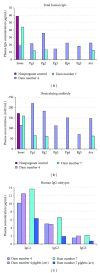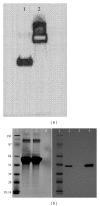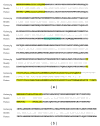Human antibodies can cross guinea pig placenta and bind its neonatal Fc Receptor: implications for studying immune prophylaxis and therapy during pregnancy
- PMID: 22991567
- PMCID: PMC3444053
- DOI: 10.1155/2012/538701
Human antibodies can cross guinea pig placenta and bind its neonatal Fc Receptor: implications for studying immune prophylaxis and therapy during pregnancy
Abstract
Despite increased use of monoclonal and polyclonal antibody therapies, including during pregnancy, there is little data on appropriate animal models that could humanely be used to understand determinants of protection and to evaluate safety of these biologics in the mother and the developing fetus. Here, we demonstrate that pregnant guinea pigs can transport human IgG transplacentally at the end of pregnancy. We also observe that human IgG binds to an engineered soluble variant of the guinea pig neonatal Fc receptor in vitro in a manner similar to that demonstrated for the human variant, suggesting that this transplacental transport mirrors the receptor-based mechanism seen in humans. Using an intravenous antihepatitis B-specific immune globulin preparation as an example, we show that this transport results in neutralizing activity in the mother and the newborn that would potentially be prophylactic against hepatitis B viral infection. These preliminary data lay the groundwork for introducing pregnant guinea pigs as an appropriate model for the evaluation of antibody therapies and advancing the health of women and neonates.
Figures



References
-
- Whitacre CC, Reingold SC, O'Looney PA, et al. Biomedicine: a gender gap in autoimmunity. Science. 1999;283(5406):1277–1278. - PubMed
-
- Okoko BJ, Enwere G, Ota MOC. The epidemiology and consequences of maternal malaria: a review of immunological basis. Acta Tropica. 2003;87(2):193–205. - PubMed
-
- Styrt B, Sugarman B. Estrogens and infection. Reviews of Infectious Diseases. 1991;13(6):1139–1150. - PubMed
-
- Abrams ET, Miller EM. The roles of the immune system in Women's reproduction: evolutionary constraints and life history trade-offs. American Journal of Physical Anthropology. 2011;146(supplement 53):134–154. - PubMed
Publication types
MeSH terms
Substances
LinkOut - more resources
Full Text Sources
Medical

